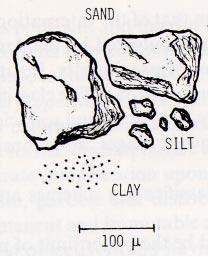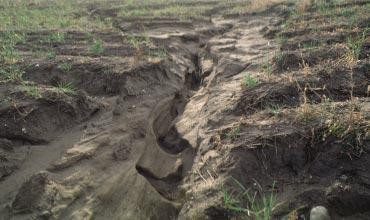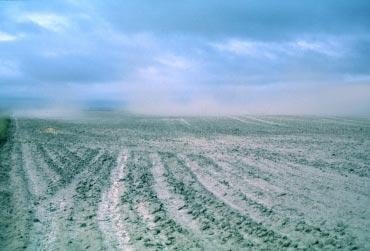Best management practices
Sustainable agriculture requires that soil and water quality be maintained. Some farm practices have the potential to cause environmental harm, which may affect rural and urban areas alike. Many of the potential negative impacts of farming can be greatly reduced by the use of Best Management Practices. These are agricultural practices that reflect current knowledge about conserving soil and water without sacrificing productivity.
Water is continually cycling. The water that we use has been used before. Producers and consumers, rural and urban people and the public and private sectors, are all responsible for using water wisely and ensuring that the resource is maintained for others. Best Management Practices are one way for the agricultural sector to help preserve water quality.
Good practices are not the same for all regions or all soil types. Among other things, management strategies should vary with the physical properties of the soil. A very important soil physical property, from the point of view of both agricultural production and the protection of water quality, is soil texture. This publication provides information about the connections between soil texture and soil management practices that protect water quality.
What is soil texture?
Mineral soils have a number of different properties that determine their usefulness to us. One of these properties is soil texture, or the proportions of different-sized mineral particles that soil contains.

Sand, silt and clay particles are dramatically different in size.
Although stones and gravel have important implications for how we manage soils, they are not considered when we measure soil texture. Three size fractions are considered: sand, silt and clay. Sands are the most apparent to us because the individual particles are visible. At the other extreme, are the clays, which are much smaller. A single gram of coarse sand would have approximately one thousand particles. A gram of clay would have approximately ninety billion particles. Silts are in the middle, but behave much more like small sand grains than clays.
Most soils are composed of a mixture of the three size fractions, but each fraction does not exert equal influence on the characteristics of a natural soil. Clays have the largest effect. They make soils sticky and able to hold water and nutrients. Silts tend to make soils slippery. Sands produce well-aerated and well-drained soils with loose structure.

Dissolved substances are readily transported through sandy soils and can contaminate water sources.
Differences in soil texture were recognized early in the history of agriculture. Sandy soils were called 'light' because they were easy to till. Silt and clay soils were called 'heavy' because of the extra energy required to pull a plough through them.
The word loam is used to indicate that the properties of all three size classes are equally evident in the soil. In naming texture classes, soils are grouped according to the dominant class and modifiers are added to indicate the secondary importance of a particular size group. For example, a silt loam shows properties of all the classes (loam) but is notably slippery when wet (silt).
Soil texture class is a result commonly reported by soil testing labs and displayed on soils maps. It is also one of the most important factors in determining crop yields.
Soil texture and agricultural contaminants
Evaluation of a good soil depends on what is being done with it and where it is located. Some of the most productive agricultural soils, in the Canadian Prairies, are soils that contain a high proportion of clay. Clay soils have a higher moisture-holding capacity; however, in a high rainfall climate, such as the British Columbia coast, that same clay soil would be difficult to farm without extensive drainage.
Contaminants move into surface water bodies attached to eroding sediment or dissolved in runoff water. Sediment can be transported by both wind and water. Dissolved compounds can also leach into ground water supplies. The risks of any of these events occurring are highly dependent on soil texture.
Best management practices for different soil textures
Good soil and water conservation practices are always recommended for all soils; however, there are a number of risks associated with particular soil textures that good farm managers should consider. Fortunately, there are also management practices that can be adopted to reduce these risks.
Sandy soils
Sandy soils have relatively large spaces between particles, which provide for rapid downward water movement. Substances, dissolved in leaching waters, are readily transported deep into the soil and potentially to groundwater. Agricultural activities such as pesticide mixing and tank rinsing, and storage of manure, fertilizer and fuels may pose particular risks on sandy soils.

In addition to moving sediment, water erosion transports many water-soluble compounds, such as pesticides and fertilizers.
Where the farm water supply is obtained from a well, the effects of contaminating an underground aquifer can be immediate and serious. One litre of oil can make two million litres of water unfit for drinking by humans. Contamination of groundwater may also have long-term impacts on many other users of the aquifer.
A high degree of caution should be exercised when storing and handling potential contaminants in areas of sandy soils. Wells should be properly sited and maintained because they can provide a 'short cut' for contaminants to reach ground water. A permanent, ten foot, grassed buffer should be maintained around the well. Sources of contamination, such as livestock and household waste water should be kept at a sufficient distance.
Over-fertilization of sandy crop land with nitrogen may lead to contamination of groundwater by leaching nitrogen. High concentrations of nitrates in drinking water are known to pose a health risk to infants and immune-suppressed individuals. Nutrient management plans should be developed and implemented to prevent over-application of fertilizers and manure.

Wind erosion is an important pathway for phosphorus losses. The majority of phosphorus in the soil is bound in soil particles.
Sandy soils have poor structure and, as a result, are highly susceptible to wind erosion. This can be an important pathway for the loading of surface waters with sediment and nutrients that are attached to eroding particles. Coarse-textured soils dry out quickly, which tends to increase wind erodability. Recommended practices include residue enhancing crop rotations, cover cropping, reduced tillage, shelterbelts and annual barriers.
Silty soils
Although all soils are potentially susceptible to water erosion, silts, silt loams and loams are most at risk. Water erosion is greatly increased on long or steep slopes where runoff can reach high velocities. Surface runoff of both dissolved and attached compounds occurs during a water erosion event.
Recommended practices for reducing water erosion include crop rotations, cover cropping, conservation tillage, contour cropping, vegetated buffer strips and grassed waterways.
Clay soils
Despite their value for dryland agriculture, soils with high clay contents have several properties which may lead to movement of contaminants from farm land. Surface structure can become degraded in clay soils, forming a crust. Crusting limits infiltration and increases runoff. When wet, clay soils are easily compacted, which also increases runoff. The runoff may contain contaminants and could affect the quality of surface and ground water. Clay-sized sediment, because of its very small size, is very slow to settle out of dugouts, streams and lakes. This can greatly increase water treatment costs.

Soil compaction results from heavy or constant traffic over an area. Clay soils are particularly susceptible. Drainage and seed germination can be adversely affected by compacted soils.
Recommended practices for reducing water erosion include crop rotations, cover cropping, conservation tillage, contour cropping, vegetated buffer strips and grassed waterways.
Clay soils may also be highly susceptible to wind erosion. Normally, clay helps form stable clods. However, under dry conditions, the surface of heavy clays may become pulverized to a condition where clods are the size of large sand grains. Particles of this size are highly wind erodible. Minimizing tillage of clay soils and maintaining surface residues will help to protect surface structure.
Recommended practices for controlling wind erosion include use of crop rotations, cover cropping, conservation tillage, shelterbelts and annual barriers.
The big picture
All soils are not created equal. A basic and important difference between soils is texture. This refers to the mixture of size particles in a soil. Soils of different textures pose different risks for the movement of contaminants from agricultural land. Knowing what soil textures make up the fields on a farm is an important step toward using management practices that maximize productivity and minimize environmental harm.
Authors: C. Hilliard and S. Reedyk
Funding: Strategic support and funding for this project has been provided by the Canada-Saskatchewan Agri-Food Innovation Fund (AFIF) and the National Soil and Water Conservation Program (NSWCP). Funding for the NSWCP is provided by Agriculture and Agri-Food Canada.